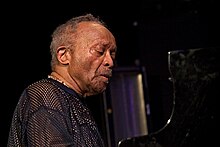Air Above Mountains (Buildings Within)
| Air Above Mountains (Buildings Within) | ||||
|---|---|---|---|---|
| Live album by Cecil Taylor | ||||
|
Publication |
||||
| Label (s) | Enja | |||
|
Format (s) |
LP / CD |
|||
|
Title (number) |
2 |
|||
|
running time |
51:17 (LP) / 76:15 (CD) |
|||
| occupation | ||||
|
Location (s) |
Moosham Castle , Austria |
|||
|
||||
Air Above Mountains (Buildings Within) is a jazz album by Cecil Taylor , which was recorded at a solo concert in Moosham Castle in the Tamsweg district ( Land Salzburg ) on August 20, 1976. The album was first released in 1978 in abridged form as an LP by Enja , before the full recording was released as a compact disc in 2002 .
The album
Several of Taylor's solo albums were released in the 1970s. The album was created on the occasion of an open air festival that Friedrich Gulda curated at Moosham Castle. There Taylor also met other musicians like Gulda, with whom he played in a duo, but also Albert Mangelsdorff , Stu Martin , Barre Phillips , John Surman and Ursula Anders ; the recording appeared on Gulda's album Message from the Country .
The concert in Austria was preceded by Taylor's 1974 solo concert at the Montreux Jazz Festival ; the pianist had played his five-part work Silent Tongues there, supplemented by two encores. It was released on the album of the same name Silent Tongues (1201 Music), which was 1974 jazz album of the year in the international critic poll of Down Beat .
In Silent Tongues , Taylor “moved skillfully between quasi-classical moods and eruptive volcanoes of dissonance,” wrote Ted Gioia :
- “ Air Above Mounatins (Buildings Within) , Fly, Fly, Fly, Fly, Fly [and] Indent complete this picture of a keyboard player as a human howitzer . In moments like this Taylor succeeds in turning the piano solo into an athletic display: Nobody in jazz - or in any other music [direction] - has attacked the keys so aggressively, has created such great sounds and overwhelmed the instrument in such a way. Strings are expected to break and pieces of ivory and ebony to fall off the keys. The experience of seeing Taylor at such a moment can defeat even opponents of free jazz with the convincing power of his genius. "
Gary Giddins goes into the special function of the encore in Taylor's solo concerts; “In its extreme brevity, it has the effect of lifting the curtain of the wizard and making it possible to understand some of his tricks in relative isolation.” In Air Above Mountains , this is reminiscent of Ray Noble's 1934 title The Very Thought of You .
Track list
- Cecil Taylor: Air Above Mountains (Buildings Within) (Enja 3005 ST)
- "Air Above Mountains (Buildings Within) part 1" - 44:22
- "Air Above Mountains (Buildings Within) part 2" - 31:53
reception

For Scott Yanow , Taylor's solo play is music that never runs out of energy. Taylor plays the piano like a drum set, with an emphasis on thunderous sounds; He only leaves these occasionally for quieter lyrical passages, which are also provided with a great deal of tension.
In the review for Allmusic , which awarded the album four stars, Scott Yanow wrote: “Except for a few brief moments, his music is quite intense, percussive, crammed and flooded with passion. Taylor's long-time fans will find much to admire here, while 'newcomers' would be well advised to turn to his earlier (and less dissonant) sessions from the 1950s first. "
The British music magazine Gramophone wrote: The air in Austria stimulated Taylor to one of his most inspired solo sets in 1976. Originally only published in excerpts on an LP, the now complete version makes sense. The wonderfully clear and detailed recording makes this an excellent example of this pianist's solos.
The French jazz hot notes: On this CD the pure energy of the concert is [captured], released by the broad sonority of the Bösendorfer .
Richard Cook and Brian Morton rated the album 3½ (out of 4) stars in The Penguin Guide to Jazz .
Craig Taborn called Taylor's concert recording as a model for his ECM album Avenging Angel (2011).
Editorial notes
The album was released in 1978 in Europe on Enja Records (3005 ST) and in the United States under license from Inner City Records (IC 3021) in a 51-minute shortened form. In 2002 the concert was re-released in the complete and remastered version on compact disc, also in Japan on Ward Records (TKCW-3219).
Individual evidence
- ↑ Ekkehard Jost: Instant Composing as body language
- ↑ Ursula Anders, Barre Phillips, Friedrich Gulda, Cecil Taylor, John Surman, Albert Mangelsdorff, Stu Martin - Nachrichten vom Lande - Galatabridge
- ↑ Information at Discogs
- ^ A b Scott Yanow : Jazz on record: the first sixty years 2003, p. 720
- ^ Henry Martin, Keith Waters: Essential Jazz: The First 100 Years , 2009. p. 202.
- ^ Ted Gioia: The History of Jazz , 2011. p. 321
- ^ Gary Giddins: Weather Bird: Jazz on the Dawn of its Second Century. Oxford University Press, Oxford, etc. 2004, ISBN 0195304497 . P. 438
- ^ Review of Scott Yanow's album on Allmusic . Retrieved June 7, 2013.
- ↑ a b Quoted from the album's liner notes
- ^ Richard Cook , Brian Morton : The Penguin Guide to Jazz Recordings . 8th edition. Penguin, London 2006, ISBN 0-14-102327-9 , p. 1268.
- ↑ David R. Adler: Craig Taborn: Alone, at Last - On Avenging Angel, acclaimed sideman Craig Taborn makes an imposing solo piano statement in JazzTimes
- ↑ Information about the album at Discogs